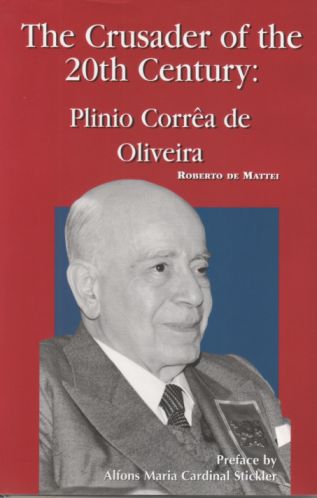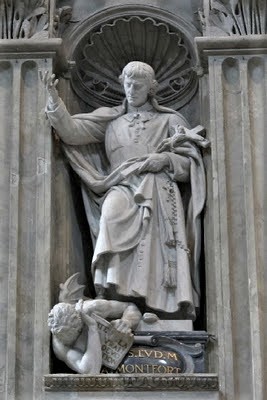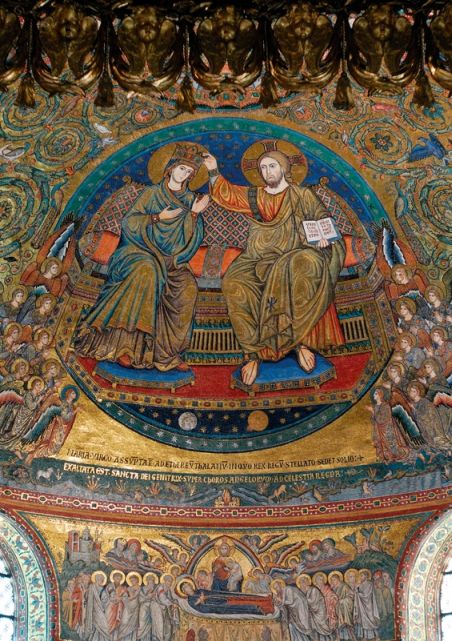|
Chapter VII
5. The Reign of Mary in the de Montfort perspective
|
|
|
Statue of St Louis de Montfort, inside St Peter's Basilica “It was through the Most Holy Virgin Mary that Jesus Christ came into the world; again it is through her that he must reign in the world.”51 The opening words of the Treatise constitute its wonderful summary. It immediately clears the field of any ambiguity by defining perfectly the distinction of nature and roles between Most Holy Mary and Jesus Christ: Mary is the means, Jesus Christ is the only end. The author furthermore establishes a relationship between two different but closely connected events: the first constituted by the Incarnation of the Word and the Nativity; the second, surrounded by mystery, because as yet unrealized, is the Kingdom of God in the world. It is a kingdom in history that, as will appear clearly from the development of the Treatise, should not be understood as Parousia, but as the triumph of his Mystical Body, the Church. This will be the result of the marvels produced once again, after the Incarnation, by the union between the Holy Spirit and the Virgin Mary.52 This Reign is defined by the saint as the Reign of Mary. “The reign especially attributed to God the Father lasted until the Flood” writes St Louis de Montfort in the Prayer for Missionaries “and ended in a deluge of water. The reign of Jesus Christ ended in a deluge of blood, but your reign, Spirit of the Father and the Son, is still unended and will come to a close with a deluge of fire, love and justice.”53 St Louis de Montfort is a prophet who announces the coming of the Reign of Mary, asking the Lord for a flood of fire of pure love that will purify mankind and that will burn “gently yet so forcefully, that all nations, Moslems, idolaters and even Jews, will be caught up in its flames and be converted”.54 When will this fortunate time come “when God’s Mother is enthroned in men’s hearts as Queen, subjecting them to the dominion of her great and princely Son? (…) That day — writes de Montfort — will dawn only when the devotion I teach is understood and put into practice: ‘Ut adveniat regnum tuum, adveniat regnum Mariae’: Lord, that your kingdom may come, may the reign of Mary come”.55
St Louis de Montfort affirms that the Reign of Mary will be a time of flourishing of the Church such as never has been known in history. He even states that, to establish this period, “the Almighty God and his holy Mother are to raise up great saints who will surpass in holiness most other saints as much as the cedars of Lebanon tower above little shrubs.”56 The way in which this special union of Mary with the souls of her apostles will be realized will in practice be the “True devotion” of which he, in the Treatise, reveals and deepens the secret. The royalty of Our Lady must be achieved in the first place inside souls; from here it will reflect on the religious and civil life of the people as a whole. “The Reign of Mary” concludes Plinio Corrêa de Oliveira “will therefore be a time when the union of souls with Our Lady will reach an intensity that is unprecedented in history, except — obviously — for individual cases. What form does this, in a certain sense, supreme union have? I do not know a more perfect means of expressing and achieving this union than the holy slavery to Our Lady, as taught by St Louis Marie Grignion de Montfort in the Treatise on the true devotion to the Blessed Virgin.”57 Notes: 50) Ibid. 51) St L. M. Grignion de Montfort, A treatise on the true devotion, no. 1. 52) “The union between the Immaculate and the Holy Spirit is so inexpressible and perfect — writes St Maximilian Maria Kolbe — that the Holy Spirit acts solely through the Immaculate, his Spouse. As a result, she is the mediatrix of all the graces of the Holy Spirit” (Letter to Fra Salesio Mikolajczyk of 28 July 1935). The Polish saint goes so far as declaring that the Immaculate “is in a certain way the incarnation of the Holy Spirit”. cf. H. M. Manteau-Bonamy, O.P., Lo Spirito Santo e l’Immacolata, (It. tr., Rome, LEMI, 1977), p. 61. 53) St L. M. Grignion de Montfort, Prayer for Missionaries, no. 16. 54) Ibid, no. 17. 55) St L. M. Grignion de Montfort, A treatise on true devotion, no. 217 56) Ibid, no. 47. On the “apostles of the latter days”, cf. A. Lhouneau, La Vierge Marie et les apôtres des derniers temps d’après le B. Louis-Marie de Montfort, Tours, Mame, 1919; H. Frehen, “Le second avènement de Jésus-Christ et la ‘méthode’ de saint Louis-Marie de Montfort”, Documentation Montfortaine, vol. 7, 1962, no. 3; Stefano De Fiores S.M.M., La ‘missione’ nell’itinerario spirituale e apostolico di S. Luigi Maria di Montfort, in Various authors, La missione monfortana ieri ed oggi, Acts of the 2nd Intermontfortan Convention (1984), Rome, Centro intermonfortano di Documentazione, 1985. 57) P. Corrêa de Oliveira, Prologue to the Argentine edition of Revolution and Counter-Revolution, p. 33. |
|



